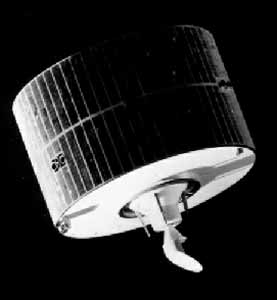Thank you very much for visiting Gunter's Space Page. I hope that this site is useful and informative for you.
If you appreciate the information provided on this site, please consider supporting my work by making a simple and secure donation via PayPal. Please help to run the website and keep everything free of charge. Thank you very much.
NATO 2A, 2B

NATO 2
NATO 2A and 2B were the first generation communication satellites to provide immediate communications links between officials of the various NATO nations.
Both the UK's Skynet-1 and the NATO's NATO-2 satellite programs resulted from the US invitation to join the IDCSP communicaten satellites system. The satellites were to be interoperable with the IDCSP svstern. and the program was initially called IDCSP/A (for augmentation).
The satellites were develloped by Philco Ford Space & Reentry Systems Division. The satellite technology was based on the IDCSP near synchronous satellites, with several improvements implemented. They featured a mechanically despun antenna, that provided increased gain relative to IDCSP and both 2 and 20 MHz channels. The only difference between the Skynet and NATO satelliteswas the antenna pattern which in case of Skynet provided a uniform global pattern and in case of NATO was shaped to cover only the NATO nations, from the eastern coast of North America to Türkiye (Turkey). The Skynet and NATO satellites were placed into a svnchronous orbit and had a stationkeeping capability. The satellites featured a solid rocket motor for apogee maneuver and hydrazine propulsion for on-orbit use.
The satellites were all launched on Delta-M rockets from Cape Canaveral.
NATO 2A was launched on 20 March 1970 and operated for 26 months.
NATO 2B was launched on 3 February 1971. It operated until August 1976.
| Nation: | USA |
|---|---|
| Type / Application: | Military communication |
| Operator: | NATO |
| Contractors: | Philco Ford Space & Reentry Systems Division |
| Equipment: | One 2 MHz and one 20 MHz bandwidth double-conversion repeater |
| Configuration: | Skynet-1 Bus |
| Propulsion: | Star-17A |
| Power: | Solar cells (body mounted), batteries |
| Lifetime: | 5 years |
| Mass: | |
| Orbit: | GEO |
| Satellite | COSPAR | Date | LS | Launch Vehicle | Remarks | |
|---|---|---|---|---|---|---|
| NATO 2A | 1970-021A | 20.03.1970 | CC LC-17A | Delta-M | ||
| NATO 2B | 1971-009A | 03.02.1971 | CC LC-17A | Delta-M |
References:
- Donald H. Martin: Communication Satellites, Aerospace Press, 1991, p 99-100
